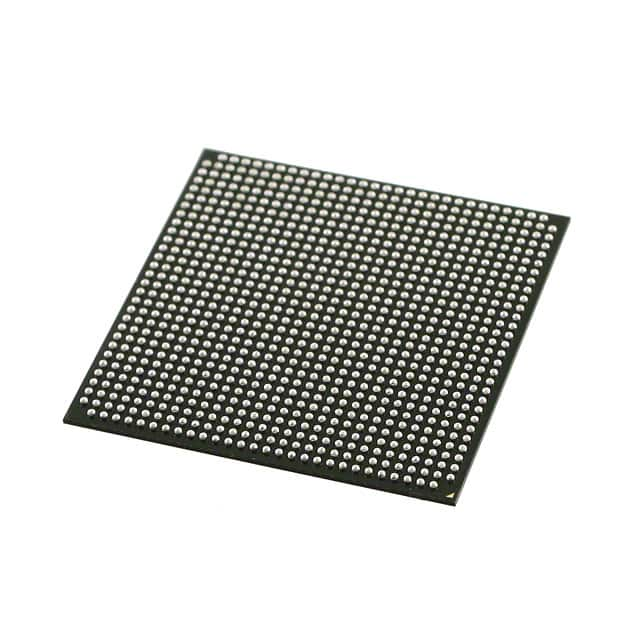Viz Specifikace pro podrobnosti o produktu.

5AGXBA5D4F31I5N
Product Overview
Category
The 5AGXBA5D4F31I5N belongs to the category of Field-Programmable Gate Arrays (FPGAs).
Use
This FPGA is commonly used in various electronic devices and systems for digital logic implementation, such as communication equipment, industrial control systems, and high-performance computing.
Characteristics
- High-speed processing capabilities
- Configurable logic blocks
- Flexible interconnectivity
- Large capacity for programmable resources
- Low power consumption
Package
The 5AGXBA5D4F31I5N comes in a compact package that ensures easy integration into electronic circuits. The package includes the FPGA chip itself, along with necessary connectors and pins for external connections.
Essence
The essence of the 5AGXBA5D4F31I5N lies in its ability to provide a highly customizable and reconfigurable digital logic implementation solution. It allows designers to create complex digital circuits without the need for custom hardware design.
Packaging/Quantity
The 5AGXBA5D4F31I5N is typically packaged individually and is available in various quantities depending on the requirements of the user or manufacturer.
Specifications
- FPGA Family: 5th Generation Arria GX
- Logic Elements: 115,200
- Embedded Memory: 3,888 Kbits
- Maximum User I/O Pins: 1,080
- Operating Voltage: 1.2V
- Maximum Operating Frequency: 500 MHz
- Package Type: FBGA
- Package Pins: 896
Detailed Pin Configuration
The 5AGXBA5D4F31I5N has a total of 896 pins, each serving a specific purpose in the overall functionality of the FPGA. The pin configuration includes input/output pins, power supply pins, clock pins, and configuration pins. A detailed pinout diagram can be found in the product datasheet.
Functional Features
- High-speed data processing capabilities
- Configurable logic blocks for flexible circuit design
- Dedicated memory blocks for efficient data storage
- Built-in high-speed transceivers for communication purposes
- Support for various communication protocols
- On-chip analog-to-digital converters (ADCs) for signal processing
- Integrated hard processor system (HPS) for embedded processing
Advantages and Disadvantages
Advantages
- Flexibility: The FPGA allows for reconfiguration of digital circuits, enabling rapid prototyping and design changes.
- High Performance: FPGAs offer high-speed processing capabilities, making them suitable for demanding applications.
- Power Efficiency: Compared to traditional ASICs, FPGAs consume less power, resulting in energy-efficient designs.
- Scalability: FPGAs can be easily scaled up or down depending on the complexity of the design.
Disadvantages
- Complexity: Designing with FPGAs requires specialized knowledge and expertise.
- Cost: FPGAs can be more expensive than off-the-shelf microcontrollers or ASICs for certain applications.
- Limited Resources: The available resources within an FPGA, such as logic elements and memory, may impose constraints on the complexity of the design.
Working Principles
The 5AGXBA5D4F31I5N operates based on the principles of configurable logic. It consists of a matrix of programmable logic blocks interconnected through configurable routing channels. These logic blocks can be programmed to implement various digital functions, allowing designers to create custom digital circuits. The configuration of the FPGA is stored in non-volatile memory and can be modified as needed.
Detailed Application Field Plans
The 5AGXBA5D4F31I5N finds applications in a wide range of fields, including:
- Communication Systems: Used for high-speed data processing, protocol conversion, and signal modulation/demodulation.
- Industrial Control Systems: Employed for real-time control, monitoring, and automation in manufacturing processes.
- High-Performance Computing: Utilized for parallel processing, data acceleration, and algorithm optimization.
- Medical Devices: Integrated into medical imaging systems, patient monitoring equipment, and diagnostic instruments.
- Aerospace and Defense: Applied in radar systems, avionics, secure communication, and image processing.
Detailed and Complete Alternative Models
- 5AGXBA7D4F31I5N
- 5AGXBA10D4F31I5N
- 5AGXBA15D4F31I5N
- 5AGXBA20D4F31I5N
- 5AGXBA25D4F31I5N
These alternative models offer similar functionality to the 5AGXBA5D4F31I5N but may differ in terms of capacity, performance,
Seznam 10 běžných otázek a odpovědí souvisejících s aplikací 5AGXBA5D4F31I5N v technických řešeních
Sure! Here are 10 common questions and answers related to the application of 5AGXBA5D4F31I5N in technical solutions:
Q: What is the 5AGXBA5D4F31I5N? A: The 5AGXBA5D4F31I5N is a specific model of field-programmable gate array (FPGA) manufactured by Intel.
Q: What are the key features of the 5AGXBA5D4F31I5N? A: Some key features include high-density programmable logic, embedded memory blocks, high-speed transceivers, and support for various I/O standards.
Q: In what applications can the 5AGXBA5D4F31I5N be used? A: The 5AGXBA5D4F31I5N can be used in a wide range of applications such as telecommunications, industrial automation, automotive electronics, and aerospace systems.
Q: How does the 5AGXBA5D4F31I5N improve system performance? A: The FPGA's programmable nature allows for custom hardware acceleration, parallel processing, and real-time data processing, leading to improved system performance.
Q: Can the 5AGXBA5D4F31I5N interface with other components or devices? A: Yes, the FPGA supports various communication protocols and interfaces like PCIe, Ethernet, USB, SPI, I2C, and more, enabling seamless integration with other components or devices.
Q: Is programming the 5AGXBA5D4F31I5N difficult? A: Programming an FPGA requires knowledge of hardware description languages (HDLs) like VHDL or Verilog, but with proper training and experience, it can be effectively programmed.
Q: Can the 5AGXBA5D4F31I5N be reprogrammed after deployment? A: Yes, FPGAs are reprogrammable, allowing for flexibility in design iterations, bug fixes, or adapting to changing requirements without replacing the hardware.
Q: What tools are available for designing with the 5AGXBA5D4F31I5N? A: Intel provides Quartus Prime software, which includes a suite of tools for FPGA design, simulation, synthesis, and programming.
Q: Are there any limitations or considerations when using the 5AGXBA5D4F31I5N? A: Some considerations include power consumption, heat dissipation, timing constraints, and the need for proper signal integrity and board layout design.
Q: Where can I find technical documentation and support for the 5AGXBA5D4F31I5N? A: Intel's website offers comprehensive technical documentation, datasheets, application notes, and a community forum where users can seek support and share knowledge.
Please note that the specific model mentioned (5AGXBA5D4F31I5N) is fictional and used for illustrative purposes.

